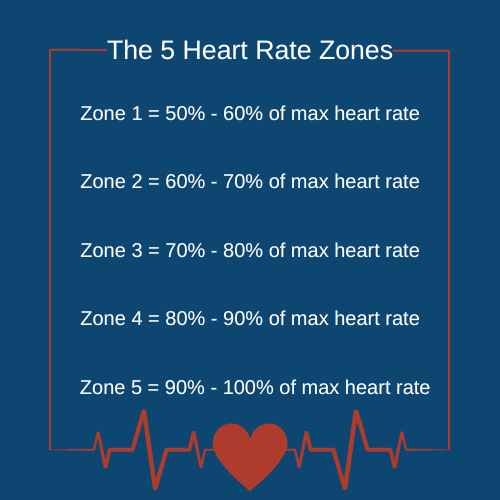What Heart Rate Zones Should You Train In?
A Fast And Easy Guide To Optimizing Your Workouts And Achieving Your Goals Through Heart Rate Zones.
What Heart Rate Zones Should You Train In?
The Cleveland Clinic states “Heart rate zones let you know how hard your heart is working and what energy source you’re using — carbohydrates or fat. The higher your heart rate gets, the more you’re relying on glycogen from carbohydrates for fuel.”
This blog post provides an informative look into heart rate zones and why they are important for your exercise routine. It explains how to calculate your maximum heart rate and how to use that information to determine your heart rate zones. We will go over each of the five heart rate zones, including the percentage of maximum heart rate associated with each zone, the type of exercises you might do in each, and the benefits of training in different heart rate zones. We will help you optimize and rework your exercise routine to achieve your fitness goals.
Disclaimer:
Please note that the information provided in this post is for educational and informational purposes only. It is not intended as a substitute for professional medical advice, diagnosis, or treatment. It is always recommended to consult with a medical professional before starting any new exercise program, especially if you have any pre-existing medical conditions or concerns.
1. Why Are Heart Rate Zones Important?
Training in different heart rate zones can have varying effects on the body, such as improving cardiovascular fitness, building endurance, and burning fat. Aiming for a specific heart rate zone while exercising can profoundly affect your ability to reach your goals.
2. How To Calculate Your Max Heart Rate
Start by finding your max heart rate (the maximum beats per minute, BPM, that your heart can reach). An easy way to figure out your max heart rate is with this formula: 220 – (your age) = max heart rate. So, if you’re 40 years old, 220 – 40 = 180. Your max heart rate would be 180 beats per minute. After finding your max heart rate, you can start calculating your heart rate zones, or your levels of intensity.
3. What Are Heart Rate Zones?
Heart rate zones are specific BPM ranges that relate to a percentage of your max heart rate. There are 5 zones and they are used as a metric for how intensely you’re exercising. Each zone can be seen in the graphic below.

4. What Zones Should You Target?
Zone 1 (50%-60%): Also called the recovery zone, this is the least intense zone. Zone 1 is where all your day-to-day activities happen and usually isn’t targeted for training purposes. Zone 1 exercises would be walking, hiking, etc…
Zone 2 (60%-70%): Zone 2 is more intense than zone 1, but still relatively low intensity. Low-intensity exercises use fat as a fuel source rather than carbohydrates. You can comfortably remain in zone 2 for a long time, as zone 2 relies on aerobic respiration, meaning that your body will have enough oxygen to carry out the exercise. Training in this zone can help improve cardiovascular fitness and endurance, making it perfect for those looking to improve their overall fitness. Examples of zone 2 exercises would be speed walking, slow jogging, cycling, or swimming.
Zone 3 (70%-80%): Also called the threshold zone, this is a bit of a gray area. It’s not entirely aerobic and not entirely anaerobic (using glycogen instead of oxygen). Most people exercise in this zone because it feels difficult but not too difficult. If you were running a 10K race, for example, you would most likely be in zone 3. This zone is used to improve your body’s ability to process lactic acid (reduce the burning sensation) and is perfect for those looking to push their limits a little more. Zone 3 exercises would be the same as zone 2, just with more intensity.
Zone 4 (80%-90%): Zone 4 is where your body switches to anaerobic respiration and uses carbohydrates for energy. The duration of each exercise significantly drops off as your body begins producing lactic acid and a burning sensation. Training in this zone can help improve speed and power, making it perfect for those looking to take their performance to the next level. Examples of zone 4 exercises would be sprinting, plyometrics, weight lifting, or HIIT.
Zone 5 (90%-100%): Zone 5 is the highest intensity zone. It is usually only used by professional athletes who are trying to optimize their performance as much as possible. Zone 5 is not recommended for the average person, but if you want to target it, the duration of each exercise drops again as lactic acid builds up and resting time needs to be increased. Training in this zone also improves speed, power, and performance, but should be done with caution and under professional guidance as it could lead to muscle damage and injury.
5. Takeaways
Each zone has its own benefits. You can target specific zones with any smart watch that measures your heart rate. The average resting heart rate (normal heart rate) for adults is 60-100 beats per minute. Generally, the high heart rate zones will burn the most total calories. If you are trying to burn fat, low heart rate zones like zones 1 and 2 are good ways to target it without much intensity and will also improve cardiovascular health. Zones 3, 4, and 5 have increasing endurance benefits, No matter what your fitness goals are, knowing what zones to target for different purposes is a useful tool to have at your disposal.
Charles Armstrong
Contributing Author
Charles Armstrong is a copywriter with a specialization in the fitness industry, and has a track record of success, having worked with Transfitnation over the course of several years. Additionally, he is an author and entrepreneur, using his skills to help others achieve their goals.
Start Your Transformation Today With A Free Training Session
We Offer Online & Studio Personal Training Based In Smithtown, NY. New Client Special.
Related Articles:

5 Effective Ways To Burn Body Fat, Reduce Hunger & Lose Weight
Do you struggle to burn body fat and lose weight? By making small changes to your eating habits, you will see how easy it is to burn body fat, reduce hunger and...
2 Powerful Tools For Meal Planning: Meal Timing & Tracking
In this article, we aim to provide you with tips and tricks to help you “perfect” your diet/meal plan through meal timing and tracking.2 Powerful Tools For Meal...

How Staying Hydrated Can Help You Reach Your Fitness Goals
Hydration offers many well-known health benefits, such as regulating body temperature, lubricating joints, and protecting the spinal cord and sensitive tissues in...

9 Best Exercises Before Shoveling Snow
Use These 9 Essential Exercises Before Shoveling Snow To Reduce Back Pain & Prevent Injuries. Warm Up Your Body & Use The Right Lifting Techniques To Make Shoveling Snow Safe & Productive.

5 Full Body Exercises That Burn The Most Calories
Here Is A Workout With 5 Full-Body Exercises To Burn Body Fat, Build Muscle, And Burn The Most Calories!5 Full Body Exercises That Burn The Most Calories Dumbbell...

Stephan Reyes Named Person of the Year 2023
Stephan Reyes was honored as TBR News Media's Person of the Year for 2023. Stephan's commitment goes beyond early morning sessions. He strives for holistic...

Best Personal Trainers on Long Island 2024- Transfitnation
Transfitnation has been nominated for Best Personal Trainer on Long Island in the 2024 Best of LI awards. With past nominations in 2021 and 2022, we showcase our...

